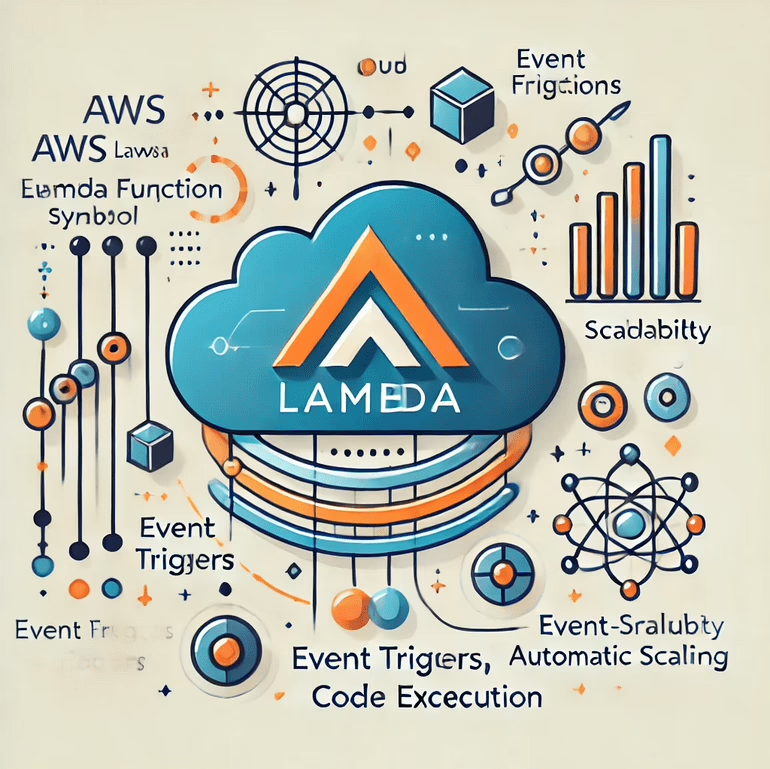In the rapidly evolving world of cloud computing, staying ahead of the curve is essential for businesses that want to remain competitive. One of the most transformative advancements in this field is serverless computing, which allows developers to focus on writing code without worrying about the underlying infrastructure. At the forefront of this revolution is AWS Lambda, a powerful service provided by Amazon Web Services (AWS) that is redefining how we build and manage applications in the cloud.
AWS Lambda offers a compelling proposition: run your code in response to events without the need to provision or manage servers. This abstraction of infrastructure management not only simplifies the development process but also enables businesses to create scalable and cost-effective solutions that can adapt to changing demands.
In this blog, we’ll explore the key features and benefits of AWS Lambda, discuss its practical applications, and highlight how Curate Consulting Services can assist you in finding the specialized talent needed to leverage this technology effectively.
Understanding AWS Lambda: The Basics
AWS Lambda is a serverless computing service that allows developers to run code without provisioning or managing servers. Instead of dealing with the complexities of infrastructure, developers can focus on writing and deploying code that responds to specific events. Whether you’re building a real-time data processing pipeline, automating workflows, or managing microservices, Lambda provides a flexible and scalable platform for your applications.
1. Serverless Computing: A Paradigm Shift
The concept of serverless computing represents a significant shift in how we think about application development. Traditional approaches require developers to manage servers, virtual machines, or containers, which can be time-consuming and resource-intensive. With AWS Lambda, this burden is lifted. AWS takes care of all the infrastructure management tasks, allowing you to concentrate on what matters most—writing code.
Lambda’s serverless nature means that you don’t have to worry about scaling your infrastructure to meet demand. AWS automatically scales your Lambda functions in response to the volume of incoming events, ensuring that your application can handle anything from a few requests per minute to thousands per second.
2. Event-Driven Architecture
One of the defining characteristics of AWS Lambda is its event-driven architecture. Lambda functions are triggered by events generated by other AWS services, custom applications, or HTTP requests. These events can include changes to an S3 bucket, updates to a DynamoDB table, or a new message in an SQS queue. The event-driven model allows for the creation of highly responsive applications that can react in real-time to changes in the environment.
For example, consider an e-commerce application where product images are uploaded to an S3 bucket. A Lambda function can be triggered to automatically resize and optimize these images, making them ready for display on the website without any manual intervention. This automation not only improves efficiency but also enhances the user experience by ensuring that images are delivered quickly and in the right format.
3. Supported Languages and Runtime
AWS Lambda supports a variety of programming languages, including Node.js, Python, Java, Ruby, C#, and PowerShell, as well as custom runtimes using the AWS Lambda Runtime API. This flexibility means that developers can use the language they’re most comfortable with, making it easier to integrate Lambda into existing workflows.
Whether you’re writing a simple Python script to process data or developing a complex Java application, Lambda’s support for multiple languages ensures that you can build functions that meet your specific requirements.
Key Features of AWS Lambda
AWS Lambda is packed with features that make it a powerful tool for building serverless applications. Here are some of the most important:
1. Function: The Core of Lambda
In AWS Lambda, a function is the fundamental unit of execution. A function is essentially a piece of code that you upload to Lambda, along with any necessary libraries, dependencies, and configurations. Once uploaded, the function can be triggered by specific events and will execute within a managed environment provided by AWS.
Functions in Lambda are designed to be lightweight and stateless, meaning they don’t retain any data between executions. This design ensures that functions can scale efficiently and execute in parallel without any conflicts.
2. Event Sources and Triggers
Lambda functions are triggered by events, which can come from a wide range of sources. These include AWS services like Amazon S3, Amazon DynamoDB, Amazon Kinesis, and AWS IoT, among others. Custom events can also be generated using AWS SDKs and APIs.
Triggers are the specific events that invoke Lambda functions. For example, you can set up a trigger to invoke a Lambda function whenever a new object is uploaded to an S3 bucket. This flexibility allows you to create sophisticated workflows and automate a wide range of tasks within your AWS environment.
3. Concurrent Execution and Scaling
AWS Lambda is designed to handle concurrent execution, meaning it can run multiple instances of a function in parallel. This capability allows Lambda to automatically scale to meet the demands of your application, whether you’re processing a single event or thousands of events simultaneously.
AWS manages the execution environment, ensuring that your functions have the necessary resources to run efficiently. This automatic scaling is one of the key benefits of Lambda, as it allows you to build applications that can handle unpredictable workloads without the need for manual intervention.
4. Resource Access and Permissions
Lambda functions can interact with other AWS services, such as databases, message queues, and storage services. To manage access to these resources, Lambda integrates with AWS Identity and Access Management (IAM). IAM roles and permissions are used to control what a Lambda function can and cannot do within your AWS environment.
For example, you might configure a Lambda function to write data to an Amazon RDS database. To do this, you’ll need to create an IAM role that grants the necessary permissions for the function to access the RDS instance securely.
5. Monitoring and Logging
Monitoring the performance of your Lambda functions is crucial for ensuring that your application runs smoothly. AWS CloudWatch provides detailed metrics, logs, and alarms that allow you to monitor your functions in real-time. CloudWatch Logs can capture the output of your function, making it easier to diagnose issues and optimize performance.
In addition to CloudWatch, AWS X-Ray can be used to trace the execution of your Lambda functions, providing insights into the overall performance and latency of your application.
6. Versioning and Aliases
Lambda allows you to publish multiple versions of a function, each with its own unique identifier. This versioning feature is useful for managing different stages of your application’s lifecycle, such as development, testing, and production.
Aliases in Lambda allow you to associate a specific version of a function with a named identifier, such as “dev,” “test,” or “prod.” This makes it easier to manage and deploy updates to your functions without affecting the overall stability of your application.
7. Integration with AWS Step Functions
AWS Step Functions is a service that allows you to coordinate and orchestrate multiple Lambda functions into workflows. With Step Functions, you can create complex, multi-step processes that involve multiple functions, services, and resources.
For example, you might create a Step Function workflow that processes an order, updates a database, sends a notification, and archives the data—all using Lambda functions. This integration allows you to build sophisticated applications that can handle a wide range of tasks and workflows.
8. VPC Integration
For applications that require access to resources within a Virtual Private Cloud (VPC), Lambda provides VPC integration. This allows your Lambda functions to securely access VPC resources, such as Amazon RDS databases, Amazon Redshift clusters, or EC2 instances.
VPC integration ensures that your Lambda functions can operate within a secure and isolated network environment, providing an additional layer of security for your application.
9. Global Reach
AWS Lambda is available in multiple regions worldwide, allowing you to run your functions closer to your users. This global reach ensures that your application can deliver low-latency performance to users regardless of their location.
Whether you’re building a global e-commerce platform or a regional data processing pipeline, Lambda’s global availability makes it easy to deploy your functions wherever they’re needed.
Practical Applications of AWS Lambda
AWS Lambda is a versatile service that can be used in a wide range of applications across different industries. Here are some common use cases:
1. Building Serverless Web Applications
Lambda is a perfect fit for building serverless web applications. By integrating Lambda with services like Amazon API Gateway, Amazon S3, and Amazon DynamoDB, you can create fully serverless applications that scale automatically and require minimal operational overhead.
For example, you could build a serverless API using Lambda and API Gateway, with the API handling requests and invoking Lambda functions to process the data. This approach allows you to build highly scalable and cost-effective web applications without the need for traditional servers.
2. Real-Time Data Processing
Lambda’s event-driven architecture makes it ideal for real-time data processing tasks. You can use Lambda to process data streams from services like Amazon Kinesis or Amazon DynamoDB Streams, allowing you to analyze and react to data in real-time.
For instance, a Lambda function could be used to process sensor data from IoT devices, analyze the data, and trigger alerts or actions based on specific conditions. This capability is invaluable for industries like manufacturing, logistics, and smart cities, where real-time data processing is critical.
3. Automating Workflows
Lambda can be used to automate a wide range of workflows within your AWS environment. For example, you might use Lambda to automatically back up data, generate reports, or trigger actions based on specific events.
By automating these tasks with Lambda, you can reduce manual effort, improve efficiency, and ensure that critical processes are executed reliably and consistently.
4. Managing Microservices
Microservices architecture is a popular approach for building scalable and maintainable applications. Lambda is well-suited for managing microservices, as it allows you to build and deploy individual functions that handle specific tasks within your application.
For example, you might have one Lambda function that handles user authentication, another that processes payments, and a third that sends notifications. Each of these functions can be developed, deployed, and scaled independently, making it easier to manage and maintain your application.
How Curate Consulting Services Can Help
As businesses increasingly adopt AWS Lambda and serverless computing, the need for specialized talent to implement, optimize, and maintain these systems becomes critical. This is where Curate Consulting Services can assist.
Specialized Talent Acquisition
At Curate Consulting Services, we specialize in finding and placing top-tier talent with expertise in AWS Lambda and other cloud services. Whether you need a cloud architect, a DevOps engineer, or a serverless application developer, we can connect you with professionals who have the skills and experience to help you succeed.
Tailored Solutions
We understand that every business is unique, with its own set of challenges and goals. That’s why we take a personalized approach to talent acquisition. We work closely with you to understand your specific needs and find candidates who not only have the technical expertise but also fit your company culture and values.
Comprehensive Support
Our support doesn’t end with talent acquisition. We offer a range of consulting services to help you at every stage of your Lambda journey, from initial setup and configuration to ongoing optimization and maintenance. Our team of experts can provide guidance on best practices, performance tuning, security, and more, ensuring that your Lambda deployment is successful and aligned with your business objectives.
Continuous Learning and Development
The technology landscape is constantly evolving, and staying up to date with the latest advancements is crucial. Curate Consulting Services is committed to continuous learning and development, both for our team and for the talent we place. We offer training and certification programs to ensure that your team is equipped with the knowledge and skills needed to leverage the full potential of AWS Lambda.
Conclusion
AWS Lambda is a powerful tool that is transforming the way businesses build and manage applications in the cloud. Its serverless nature, event-driven architecture, and automatic scaling make it an ideal choice for a wide range of applications, from web development to real-time data processing.



